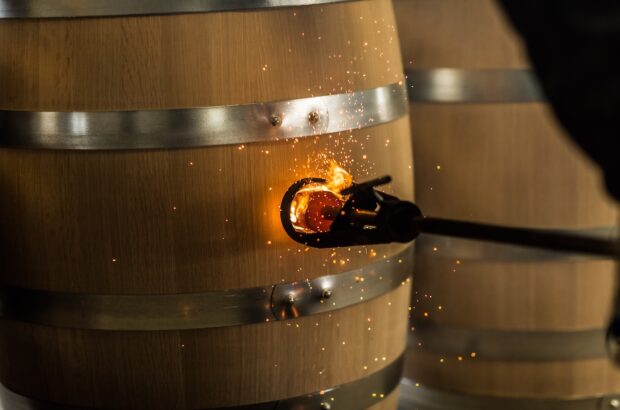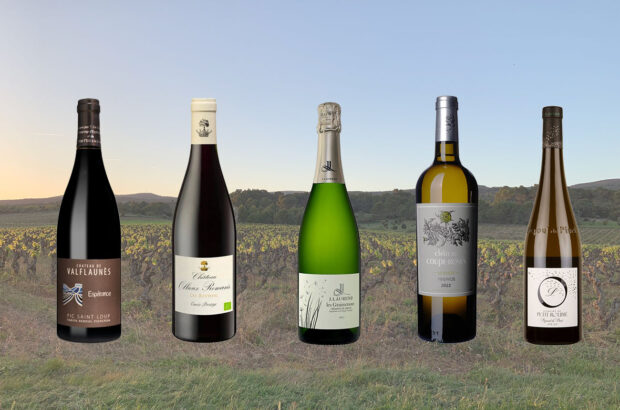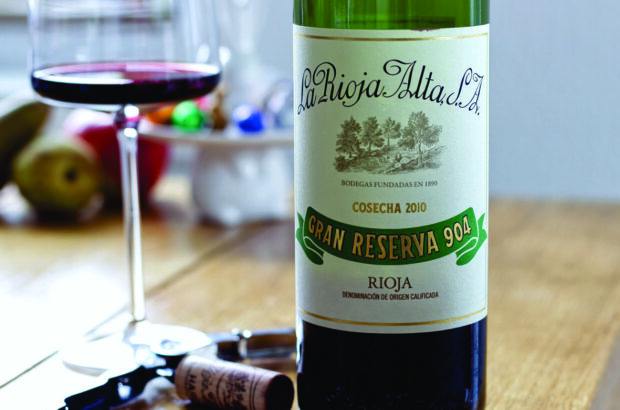To begin with a confession: when I started to study blind tasting, Tempranillo was the one red variety that I could rarely spot. Even now I sometimes have to circle round it and eliminate all the others first. Syrah, yes, Cabernet Sauvignon, always, Merlot and Pinot Noir or Nebbiolo, no problem. I can even make a calculated guess at Nerello Mascalese. The problem – for me at least – is that Tempranillo is Spain’s most widely planted red, and has many different profiles. Since Spain is a mountainous country, with seas on several sides, significant rivers and a mix of soils, there is exceptional diversity. No wonder the fruit character varies. Fresh cherry? Morello cherry? Cherry jam? Plum? Blackcurrant? Then there’s its savoury character: sweet spices, a slightly leathery feel, sometimes leafy. There can be a fine freshness too.
{"content":"PHA+VW5mb3J0dW5hdGVseSwgdGhlIGRlZmluaW5nIGNsdWUsIHRoZSBldmlkZW5jZSBmb3IgdGhlIHByb3NlY3V0aW9uLCB3YXMgYWx3YXlzIG9hazogQW1lcmljYW4gb2FrLCBhbmQgbG90cyBvZiBpdC4gSWYgeW91IGNvdWxkIHNwb3QgY29jb251dHR5IEFtZXJpY2FuIG9haywgdGhlbiB5b3Ugd2VyZSBob21lIGFuZCBkcnkuIEl0IHdhcyBzYWZlbHkgU3BhbmlzaCwgbGlrZWx5IFJpb2phLCBhbmQgdGhlcmVmb3JlIGhhZCB0byBiZSBUZW1wcmFuaWxsbyDigJMgZXZlbiBpZiBpdCBoYWQgb3RoZXIgdmFyaWV0aWVzIGluIHRoZSBibGVuZC4gSSBzYXkg4oCYdW5mb3J0dW5hdGVseeKAmSBiZWNhdXNlIHRoaXMgbmFycm93IHZpZXcgb2YgU3BhaW4gYXMg4oCYVGVtcHJhbmlsbG8gKyBvYWvigJkgc3RpbGwgc3RpY2tzLCBldmVuIHRob3VnaCB0aGUgd2luZW1ha2luZyBoYXMgY2hhbmdlZCBncmVhdGx5LiBGdXJ0aGVyLCB0aGlzIHN3ZWVwaW5nIHZpc2lvbiBvZiBTcGFpbiBhcyBkb21pbmF0ZWQsIHVuaW1hZ2luYXRpdmVseSwgYnkgVGVtcHJhbmlsbG8gaXMgYXMgZGFtYWdpbmcgZm9yIHRoZSByZXB1dGF0aW9uIG9mIFNwYWlu4oCZcyB3aW5lIGluZHVzdHJ5IGFzIGl0IGlzIGZvciBUZW1wcmFuaWxsbyBpdHNlbGYuPC9wPgo8cD48ZGl2IGNsYXNzPSJhZC1jb250YWluZXIgYWQtY29udGFpbmVyLS1tb2JpbGUiPjxkaXYgaWQ9InBvc3QtaW5saW5lLTEiIGNsYXNzPSJpcGMtYWR2ZXJ0Ij48L2Rpdj48L2Rpdj48L3A+CjxibG9ja3F1b3RlPgo8cD7igJhXaGlsZSBUZW1wcmFuaWxsbyBpcyBTcGFpbuKAmXMgbW9zdCB3aWRlc3ByZWFkIHZhcmlldHksIGl0IGlzIGFsc28gaXRzIG1vc3QgdW5kZXJyYXRlZOKAmTwvcD4KPC9ibG9ja3F1b3RlPgo8cD5JbiB0aGUgbGFzdCBkZWNhZGUsIEdhcm5hY2hhLCBNZW5jw61hIGFuZCBvdGhlciBsZXNzZXIgcmVnaW9uYWwgc3BlY2lhbGl0aWVzIHN1Y2ggYXMgTW9uYXN0cmVsbCwgQ2FyacOxZW5hLCBCb2JhbCBhbmQgR3JhY2lhbm8gYXJlIHByb3ZpZGluZyBmYXIgbW9yZSBpbnRlcmVzdC4gVGVtcHJhbmlsbG8ganVzdCBpc27igJl0IOKAmGNvb2zigJkgYW55bW9yZS4gSXTigJlzIG5vdCB1c3VhbCB0byBzZWFyY2ggdW5kZXIg4oCYVOKAmSBvbiBhIHdpbmUgbGlzdC4gKFNlYXJjaGluZyB1bmRlciDigJhQ4oCZIGZvciBQaW5vdCBpcyBhIGRpZmZlcmVudCBtYXR0ZXIuKSBUaGUgd2luZSB3b3JsZCBpcyBzZWFyY2hpbmcgZm9yIG5vdmVsdHksIGFuZCBUZW1wcmFuaWxsbyBpcyBub3QgbmV3LiBNeSB0aGVzaXMgaXMgdGhhdCB3aGlsZSBUZW1wcmFuaWxsbyBpcyBTcGFpbuKAmXMgbW9zdCB3aWRlc3ByZWFkIHZhcmlldHksIGl0IGlzIGFsc28gaXRzIG1vc3QgdW5kZXJyYXRlZC4gVGhlcmUgYXJlIHN0aWxsIHNvbWUgcGxhY2VzIHdoZXJlIGl0IGhhcyBvdXRzdGF5ZWQgaXRzIHdlbGNvbWUsIGJ1dCB0aGVyZSBhcmUgbWFueSBzaXRlcyB3aGVyZSBpdCBzaW5ncy48L3A+CjxwPkluIFNwYWluLCBpdHMgc3lub255bXMgcmFuZ2UgZnJvbSBDZW5jaWJlbCAoQ2FzdGlsbGEtTGEgTWFuY2hhKSBhbmQgVWxsIGRlIExsZWJyZSAoQ2F0YWxvbmlhKSB0byBhIHNlbGVjdGlvbiBhcm91bmQgVGludG8gRmluby9UaW50YSBkZWwgUGHDrXMvVGludGEgRmluYS9UaW50YSBkZSBUb3JvIGFjcm9zcyB0aGUgY291bnRyeeKAmXMgY2VudHJhbCBhbmQgbm9ydGhlcm4gcGFydHMuIE9mIHRoZSB3b3JsZOKAmXMgMjMxLDAwMGhhIG9mIFRlbXByYW5pbGxvLCA4OCUgaXMgaW4gU3BhaW4gKE9JViwgMjAxNykuIFRoZSB2YXJpZXR5IGhhcyB0cmF2ZWxsZWQgdGhlIHdvcmxkIChzZWUgdGFzdGluZyBub3RlcywgcDYxKSwgZnJvbSBQb3J0dWdhbCAoVGludGEgUm9yaXosIEFyYWdvbmV6KSB0byBJdGFseSwgdG8gdGhlIFVTIChDYWxpZm9ybmlhLCBXYXNoaW5ndG9uLCBPcmVnb24sIFRleGFzKSwgTWV4aWNvLCBBcmdlbnRpbmEsIEF1c3RyYWxpYSBhbmQgTmV3IFplYWxhbmQuIEluIGV2ZXJ5IGNhc2UgZXhjZXB0IFBvcnR1Z2FsIGFuZCBwZXJoYXBzIFRleGFzLCBpdOKAmXMgYSBsZXNzZXIsIGFsdGVybmF0aXZlIHZhcmlldHkuPC9wPgo8cD48ZGl2IGNsYXNzPSJhZC1jb250YWluZXIgYWQtY29udGFpbmVyLS1tb2JpbGUiPjxkaXYgaWQ9InBvc3QtaW5saW5lLTIiIGNsYXNzPSJpcGMtYWR2ZXJ0Ij48L2Rpdj48L2Rpdj48L3A+CjxwPlRoYXQgc2FpZCwgaXQgaGFzIGEgbnVtYmVyIG9mIHN0ZXJsaW5nIHF1YWxpdGllcy4gSXTigJlzIGFkYXB0YWJsZSB0byBhIHJhbmdlIG9mIHRlcnJvaXJzLCBhbmQgaXMgZXF1YWxseSBhZGFwdGFibGUg4oCTIHNvbWUgbWlnaHQgc2F5IHN1Ym1pc3NpdmUg4oCTIHdoZW4gaXQgY29tZXMgdG8gYmxlbmRpbmcgYW5kIG9hayBhZ2VpbmcuIEl0IGhhcyBmaXJtIHRhbm5pbi4gQXMgaXRzIG5hbWUgc3VnZ2VzdHMsIGl0IHJpcGVucyBlYXJseSDigJMgdXAgdG8gdHdvIHdlZWtzIGVhcmxpZXIgdGhhbiBHYXJuYWNoYSBpbiBSaW9qYSwgZm9yIGluc3RhbmNlLiBJdOKAmXMgc2Vuc2l0aXZlIHRvIHdpbmQgYW5kIGRyb3VnaHQsIHdoaWNoIG1pZ2h0IGJlY29tZSBhbiBpc3N1ZSBpbiBjb21pbmcgeWVhcnMsIGFuZCBzdXNjZXB0aWJsZSB0byBwb3dkZXJ5IG1pbGRldy4gVGhlIGRvd25zaWRlcyB0byBUZW1wcmFuaWxsbyBhcHBlYXIgaWYgeW91IHJlbHkgb24gaXQgYXMgeW91ciBzb2xlIHZhcmlldHk6IGl0IGNhbiBiZSBtb2RlcmF0ZSBvciBsb3cgaW4gYWNpZGl0eSwgYW5kIGlmIHlvdSBsZXQgaXQgb3ZlcmNyb3AsIHRoZSBjb2xvdXIgYW5kIHBhbGF0ZSBhcmUgbGlnaHQuIE1hbnkgZ3Jvd2VycyBhcmUgc2Vla2luZyBvdXQgb2xkZXIgbWF0ZXJpYWwgdG8gcmVwbGFjZSBtb2Rlcm4gcHJvZHVjdGl2ZSBjbG9uZXMgYW5kIHRodXMgcmVzdG9yZSBkaXZlcnNpdHkgYW5kIGNvbmNlbnRyYXRpb24gdG8gdGhlaXIgdmluZXMuPC9wPgo8aDM+UmliZXJhIGRlbCBEdWVybzwvaDM+CjxwPkZvciBhbnkgc3R1ZGVudCBvZiBUZW1wcmFuaWxsbywgdGhlIHBsYWNlIHRvIGJlZ2luIGlzIFJpYmVyYSBkZWwgRHVlcm8uIFJpb2phIG1heSBiZSBtb3JlIGZhbW91cywgYnV0IG1hbnkgUmlvamFzIGFyZSBibGVuZHMsIHdoZXJlYXMgUmliZXJhIGRlbCBEdWVybyBpcyB0aGUgbGFuZCBvZiBUaW50byBGaW5vLiBOb3QgdGhhdCBpdCBpcyBlYXN5IHRvIGZvbGxvdy4gVGhlIGRpdmVyc2l0eSBvZiBzb2lscyBhbmQgYWx0aXR1ZGVzIGdpdmVzIGFuIGFycmF5IG9mIGNoYXJhY3RlcnMsIGJ1dCBoaXRoZXJ0byB0aGlzIGhhcyBvZnRlbiBiZWVuIG1hc2tlZCBieSB0aGUgd2luZW1ha2luZy4gQSByZWxpYWJsZSB0dXRvciBpbiB0aGlzIGFyZWEgaXMgTWFyaWFubyBHYXJjw61hLiBBcyB3aW5lbWFrZXIgYXQgVmVnYSBTaWNpbGlhIGZvciAzMCB5ZWFycywgaGUgcHJvdmVkIHRoYXQgVGludG8gRmlubyBoYXMgdGhlIGNhcGFjaXR5IHRvIG1ha2Ugd2luZXMgdGhhbiBjYW4gbGFzdCBmb3IgNTAgb3IgbW9yZSB5ZWFycy4gVGhlcmUgYXJlIG90aGVyIGdyYXBlIHZhcmlldGllcyBpbiBoaXMgYmxlbmRzLCBidXQgVGludG8gRmlubyBpcyB0aGUgaGVhcnQuPC9wPgo8cD5BcyBhIGxvY2FsLCBHYXJjw61hIGtub3dzIHRoZSB2aWxsYWdlcyBhbmQgdGhlIG9sZCB2aW5lcy4gU28gd2hlbiBoZSBzZXQgdXAgQWFsdG8gd2l0aCBKYXZpZXIgWmFjY2FnbmluaSwgdGhlIHBhaXIga25ldyB3aGVyZSB0byBsb29rIHRvIGFzc2VtYmxlIHRoZWlyIDIwMCBwbG90cyBmcm9tIGFjcm9zcyBSaWJlcmEuIE5vdywgMjAgeWVhcnMgb24sIHRoZSB3aW5lcyBvZmZlciBhIGZhc2NpbmF0aW5nIGludGVycHJldGF0aW9uIGFuZCB0aGUgZmlybSB0YW5uaW5zIGFyZSBzb2Z0ZW5pbmcgaW50byBtYXR1cml0eTogVGVtcHJhbmlsbG8gdGFtZWQuPC9wPgo8ZGl2IGNsYXNzPSJhZC1jb250YWluZXIgYWQtY29udGFpbmVyLS1tb2JpbGUiPjxkaXYgaWQ9InBvc3QtaW5saW5lLTMiIGNsYXNzPSJpcGMtYWR2ZXJ0Ij48L2Rpdj48L2Rpdj4KPHA+VGhlIFJpYmVyYSBkZWwgRHVlcm8gRE8gd2FzIG9ubHkgZm9ybWVkIGluIDE5ODIsIGRlc3BpdGUgVmVnYSBTaWNpbGlh4oCZcyBmb3VuZGluZyBpbiAxODY0IGFuZCBQcm90b3MgaW4gMTkyNy4gVW5kZXJzdGFuZGluZyB0aGUgcHJvZmlsZSBvZiBUaW50byBGaW5vIGFuZCBob3cgdG8gZXhwcmVzcyBpdCBiZXN0IGhhcyB0YWtlbiB0aW1lLiBJdOKAmXMgZmFpciB0byBzYXkgdGhhdCB0aGUgZXhwZXJ0cyBpbiBUZW1wcmFuaWxsbyBmcm9tIFJpb2phIHdobyBoYXZlIGNvbWUgdG8gbWFrZSB3aW5lIGluIHRoZSBETyBzdGlsbCBtYWtlIGJldHRlciB3aW5lIGF0IOKAmGhvbWXigJkgaW4gUmlvamEgdGhhbiBpbiBSaWJlcmEgZGVsIER1ZXJvLiBGb3Igd2luZXJpZXMgc3VjaCBhcyBSYW3Ds24gQmlsYmFvLCBSaW9qYSBBbHRhLCBSb2RhIGFuZCBtb3JlIHJlY2VudGx5IENWTkUsIGZvciBpbnN0YW5jZSwgaXTigJlzIGEgd29yayBpbiBwcm9ncmVzcy4gSXTigJlzIHRoZSBzYW1lIGluIHRoZSBvdGhlciBkaXJlY3Rpb246IFZlZ2EgU2ljaWxpYeKAmXMgUmliZXJhIGRlbCBEdWVyby1tZWV0cy1Cb3JkZWF1eCBqb2ludCB2ZW50dXJlIHdpdGggQmVuamFtaW4gZGUgUm90aHNjaGlsZCwgTWFjw6FuLCBoYXMgdGFrZW4gdGltZS4gVGludG8gRmlubyBpcyBub3QgVGVtcHJhbmlsbG8gaW4gdGhlIHZpbmV5YXJkLCBhbmQgdmljZSB2ZXJzYS48L3A+CjxwPlRvIHVuZGVyc3RhbmQgdGhlIHZhcmlldHkgZnVydGhlciwgeW91IG5lZWQgdG8gYWRkIGludG8gdGhlIG1peCBhIGxvdmVseSBidXQgZGlzdGluY3RseSBkaWZmZXJlbnQgZXhwcmVzc2lvbiBvZiBUaW50byBGaW5vIGF0IHRoZSBmYXIgZWFzdGVybiBlbmQgb2YgdGhlIERP4oCZcyDigJhnb2xkZW4gbWlsZeKAmSwgaW4gU29yaWEsIFNwYWlu4oCZcyBsZWFzdCBwb3B1bGF0ZWQgcHJvdmluY2UuIEhlcmUsIHRoZXJl4oCZcyBhIHJlYWwgc2Vuc2Ugb2YgYSBsYW5kIHRoYXQgdGltZSBmb3Jnb3QuIEZvcm1lcmx5IG9mIERvbWluaW8gZGUgQXRhdXRhLCBGcmVuY2htYW4gQmVydHJhbmQgU291cmRhaXMgaXMgbm93IGF0IEFudMOtZG90byBhbmQgRG9taW5pbyBkZSBFcywgYW5kIGhlIHByb2R1Y2VzIGV4Y2VwdGlvbmFsbHkgZGVsaWNhdGUgd2luZXMgaW4gdmluZXlhcmRzIGF0IDkwMG0tMSwxMDBtLiBUaGUgc29pbHMgcmFuZ2UgZnJvbSBzYW5kIGFuZCBncmF2ZWwgdG8gbGltZXN0b25lLCBhbmQgaGUgc291cmNlcyBmcm9tIHNldmVyYWwgaHVuZHJlZCBwbG90cyBhY3Jvc3MgYWxtb3N0IGEgZG96ZW4gdmlsbGFnZXMuIEhpcyByb3PDqXMgYXJlIHNvbWUgb2YgdGhlIHZlcnkgYmVzdCBpbiBTcGFpbi4gVGhlIHNpbmdsZS12aW5leWFyZCBMZSBSb3PDqSDigJMgNTAlIFRpbnRvIEZpbm8sIDUwJSBBbGJpbGxvICh3aGl0ZSkg4oCTIGlzIGZyb20gODAtIHRvIDEwMC15ZWFyLW9sZCB2aW5lcyBhdCAxLDAwMG0sIGdyb3duIG9uIHNhbmR5IHNvaWwgb24gYSBiYXNlIG9mIGNhbGNhcmVvdXMgcm9jay4gSXQgaXMgYWdlZCBpbiBuZXcgNjAwLWxpdHJlIGJhcnJlbHMsIGFuZCBoaXMgaW50ZW50aW9uIHdpdGggaXQgaXMg4oCYdG8gY29tcGV0ZSBkaXJlY3RseSB3aXRoIHRoZSB3b3JsZCBlbGl0ZSBvZiByb3PDqXPigJkuIEhlIGRvZXMsIHN1Y2Nlc3NmdWxseS4gRm9yIGEgY2hlYXBlciBvcHRpb24sIFJvc2VsaXRvIGlzIGFsc28gdmVyeSBnb29kIChhIGJsZW5kIG9mIDcwJSBUaW50byBGaW5vIGFuZCAzMCUgQWxiaWxsbykuPC9wPgo8ZGl2IGNsYXNzPSJhZC1jb250YWluZXIgYWQtY29udGFpbmVyLS1tb2JpbGUiPjxkaXYgaWQ9InBvc3QtaW5saW5lLTQiIGNsYXNzPSJpcGMtYWR2ZXJ0Ij48L2Rpdj48L2Rpdj4KPGgzPkNhc3RpbGxhIHkgTGXDs248L2gzPgo8cD5CZXlvbmQgUmliZXJhIGRlbCBEdWVybyBsaWVzIHRoZSBleHRlbnNpdmUgRE8gb2YgQ2FzdGlsbGEgeSBMZcOzbiB3aXRoIGl0cyBtYW55IGhlY3RhcmVzIG9mIFRlbXByYW5pbGxvLCBtYW5hZ2VkIGJ5IGFueSBudW1iZXIgb2YgaW5kZXBlbmRlbnQtbWluZGVkIHdpbmVyaWVzLCB3aGljaCBkb27igJl0IGhhcHBlbiB0byBmaXQgaW50byB0aGUgc29tZXRpbWVzLWFyYml0cmFyeSBib3VuZGFyaWVzLiBPbmUgc3VjaCB3aW5lcnkgaXMgQWJhZMOtYSBSZXR1ZXJ0YS4gSXTigJlzIGEgbHV4dXJ5IHByb2plY3QgYXR0YWNoZWQgdG8gdGhlIHJlZ2lvbuKAmXMgbW9zdCBsYXZpc2ggaG90ZWwsIGNvbXBsZXRlIHdpdGggYSBNaWNoZWxpbi1zdGFycmVkIHJlc3RhdXJhbnQuIFRoZXNlIGFyZSBlc3RhdGUgd2luZXMsIHdpdGggc2V2ZXJhbCBzaW5nbGUtdmFyaWV0YWwsIHNpbmdsZS12aW5leWFyZCBjaG9pY2VzOiBTeXJhaCwgQ2FiZXJuZXQgU2F1dmlnbm9uIGFuZCBUZW1wcmFuaWxsby4gQW5nZWwgQW7Ds2NpYmFyIGlzIHByb3VkIG9mIHRoZSBUZW1wcmFuaWxsbyB0b28sIGNsZWFybHkgbGFiZWxsaW5nIHRoZSB2YXJpZXR5IG9uIHRoZSBib3R0bGUuIFRlbXByYW5pbGxvIGlzIOKAmGNvb2zigJkgaGVyZSwgYW5kIHByb3VkLjwvcD4KPHA+VGhlIGhpZ2h3YXlzIGhlcmVhYm91dHMgYXJlIGZpbGxlZCB3aXRoIHdpbmVtYWtlcnMsIGdyb3dlcnMgYW5kIHRoZSBvY2Nhc2lvbmFsIHdpbmUgd3JpdGVyLiBWYWxsYWRvbGlkIGlzIGVxdWlkaXN0YW50IGZyb20gVG9ybywgUnVlZGEgYW5kIHRoZSBoZWFydCBvZiBSaWJlcmEgZGVsIER1ZXJvLCBqdXN0IDQ1IG1pbnV0ZXPigJkgZHJpdmUuIE9uZSBmYW1pbHkgb24gdGhlIHJvYWQgaXMgdGhlIEdhcmPDrWFzOiBNYXJpYW5vIGFuZCBoaXMgc29ucyBydW4gR2FybcOzbiBpbiBSaWJlcmEgZGVsIER1ZXJvLCBNYXVybyBpbiBDYXN0aWxsYSB5IExlw7NuIGFuZCBNYXVyb2RvcyAoYWxzbyBrbm93biBhcyBTYW4gUm9tw6FuKSBpbiBUb3JvLiBJdOKAmXMgbm8gc3VycHJpc2UgdGhhdCBUb3JvIGhhcyBzZWVuIHBsZW50eSBvZiBpbnZlc3RtZW50IGZyb20gUmliZXJhIGRlbCBEdWVybyBhbmQgYmV5b25kLiBUaGUgbG93ZXIgbGFuZCBwcmljZXMgd2VyZSBhIGRyYXcuPC9wPgo8ZGl2IGNsYXNzPSJhZC1jb250YWluZXIgYWQtY29udGFpbmVyLS1tb2JpbGUiPjxkaXYgaWQ9InBvc3QtaW5saW5lLTUiIGNsYXNzPSJpcGMtYWR2ZXJ0Ij48L2Rpdj48L2Rpdj4KPGJsb2NrcXVvdGU+CjxwPuKAmFRvcm8gd2lsbCBhbHdheXMgYmUgYSBmb3J0aHJpZ2h0IHdpbmUsIGJ1dCBpbnZlc3RtZW50IGluIHZpdGljdWx0dXJlIHRyYW5zZm9ybXMgdGhlIHJ1c3RpY2l0eeKAmTwvcD4KPC9ibG9ja3F1b3RlPgo8cD5UaGUgcGh5bGxveGVyYS1mcmVlLCBkcnksIHNhbmR5IHNvaWxzIGFyZSBhbHNvIGEgbHVyZTogc29tZSA2MCUgb2YgdGhlIHZpbmVzIGFyZSBvd24tcm9vdGVkLCBhbmQgODAlIGFyZSBidXNoIHZpbmVzLiBXaGVuIFRvcm8gRE8gd2FzIGZvdW5kZWQgaW4gMTk4NywgdGhlcmUgd2VyZSBmb3VyIGJvZGVnYXM7IHRvZGF5IHRoZXJlIGFyZSA2My4gQWxzbyBmcm9tIFJpYmVyYSBkZWwgRHVlcm8gYXJlIFZlZ2EgU2ljaWxpYSBhbmQgQWxvbnNvIGRlbCBZZXJyby4gTFZNSCBoYXMgTnVtYW50aGlhLCB3aGljaCB3YXMgZm91bmRlZCBieSB0aGUgRWd1cmVucyBmcm9tIFJpb2phLCB3aG8gbm93IGhhdmUgVGVzbyBMYSBNb25qYS4gTm90IGZvcmdldHRpbmcgTWljaGVsIFJvbGxhbmQsIFRlbG1vIFJvZHLDrWd1ZXosIEpvcmdlIE9yZMOzw7FleiBhbmQgRG9tYWluZXMgTWFncmV6IEVzcGFnbmUuIFRoaXMgaXMgVGVtcHJhbmlsbG8gaGlnaCBjb3VudHJ5LiBIaXN0b3JpY2FsbHkgaXQgbWFkZSBkaXJlY3QsIGFsY29ob2xpYyBibG9ja2J1c3RlcnMsIGFuZCB3aGlsZSBUb3JvIHdpbGwgYWx3YXlzIGJlIGEgZm9ydGhyaWdodCB3aW5lLCB0aGlzIGludmVzdG1lbnQgaW4gdml0aWN1bHR1cmUgaXMgdHJhbnNmb3JtaW5nIHRoZSBydXN0aWNpdHkuPC9wPgo8cD5Gb3IgVG9yb+KAmXMgbmVpZ2hib3VyIFJ1ZWRhLCBUZW1wcmFuaWxsbyBpcyB0aGUgcHJlZmVycmVkIHJlZC4gVW5kZXJzdGFuZGFibHkgcGVyaGFwcywgZ2l2ZW4gaXRzIGZvY3VzIG9uIHdoaXRlIHdpbmVzLCBSdWVkYeKAmXMgcmVkcyBhcmUgbm90IHRoZSBoaWdobGlnaHQuIE1vcmUgc3VjY2Vzc2Z1bCBpcyBpdHMgb3RoZXIgbmVpZ2hib3VyIENpZ2FsZXMuIEl0IGhhcyBqdXN0IDEsODIwaGEgb2YgdmluZXlhcmQsIGJ1dCBtYWlubHkgb2xkIGJ1c2ggdmluZXMgb24gc3RvbnksIHJvY2t5IHNvaWxzLCB1cCB0byA4MDBtLiBUaGUgaGVhdCBhbmQgZHJvdWdodCBjcmVhdGUgY29uY2VudHJhdGVkIHdpbmVzLiBXaXRoIGdvb2QgbWFuYWdlbWVudCwgVGVtcHJhbmlsbG8gaXMgdHJhbnNmb3JtaW5nIGl0c2VsZiBmcm9tIHRoZSBmb3JtZXIgYWxjb2hvbGljLCBiYWtlZCByZWQuPC9wPgo8aDM+UmlvamE8L2gzPgo8cD5UaGUgam91cm5leSB0byBSaW9qYSBpcyBhIGdvb2QgdHdvLWhvdXIgZHJpdmUuIEkgc3VnZ2VzdCBzdG9wcGluZyBvZmYgYW5kIG1lZXRpbmcgc29tZSBvZiB0aGUgcGVvcGxlIGluIHRoZSB3aW5lIHdvcmxkIGRvaW5nIHRoZSBzYW1lIGF0IExhbmRhLCBhIGhvdGVsIGp1c3Qgb2ZmIHRoZSBtb3RvcndheSBhdCBCdXJnb3MuIEl04oCZcyBhIGNydXNoIGluIHRoZSBiYXIsIGJ1dCBhIGdsYXNzIG9mIGEganVpY3kgeW91bmcgVGVtcHJhbmlsbG8gd2l0aCBsb2NhbCBtb3JjaWxsYSwgYSB0eXBlIG9mIGJsYWNrIHB1ZGRpbmcsIGFuZCBhIGZyaWVkIGVnZyBicmVha3MgdXAgdGhlIGpvdXJuZXksIGFuZCB5b3Ugd2lsbCBiZSBzdXJlIHRvIG1lZXQgYSBmcmllbmQgaWYgeW91IHN0YXkgbG9uZyBlbm91Z2guPC9wPgo8cD5XZSBhcmUgZW50ZXJpbmcgdGhlIERPQ2EsIHdoZXJlIFRlbXByYW5pbGxvIGlzIGFsdG9nZXRoZXIgbW9yZSBjb21wbGljYXRlZCBmb3IgYSBzdHVkZW50LCB0aG91Z2ggaXQgbmV2ZXIgdXNlZCB0byBiZSBzby4gRmlyc3QsIHRoZXJlIHdhcyB0aGUgUmlvamEgdHJhZGl0aW9uIG9mIGJsZW5kaW5nIEdhcm5hY2hhLCBNYXp1ZWxvIGFuZCBHcmFjaWFubyBpbnRvIHRoZSB3aW5lLiBOb3cgMTAwJSBUZW1wcmFuaWxsbyBpcyBtdWNoIG1vcmUgY29tbW9uLiBTZWNvbmQsIFJpb2phIHdpbmUgdXNlZCB0byBiZSBjYXRlZ29yaXNlZCBieSBpdHMgdGltZSBzcGVudCBpbiBiYXJyZWwsIHdpdGggbGl0dGxlIGNsdWUgdG8gcXVhbGl0eSDigJMgbWFueSBwcm9kdWNlcnMgaGF2ZSBhYmFuZG9uZWQgdGhpcyBhcHByb2FjaC4gVGhpcmQsIHRoZXJlIHdhcyBhIGRpc3RpbmN0IG1vdmUgdG93YXJkcyBGcmVuY2ggb2FrLCBhd2F5IGZyb20gQW1lcmljYW4uIE5vdyB0aGUgcGVuZHVsdW0gc2VlbXMgdG8gYmUgc3dpbmdpbmcgYmFjayBhIGxpdHRsZSwgd2l0aCBzb21lIHByb2R1Y2VycyBhbHNvIG1ha2luZyB0aGVpciB3aW5lcyBpbiBjb25jcmV0ZSBvciBhbXBob3JhZS4gQW5kIGZvdXJ0aCwgZXZlbiBtb3JlIHZhcmlhYmxlcyBoYXZlIGVudGVyZWQgdGhlIG1peCBvZiBvZmZpY2lhbCB0ZXJtaW5vbG9neSwgc3VjaCBhcyB2aWxsYWdlIHdpbmVzIGFuZCDigJhzaW5ndWxhciB2aW5leWFyZHPigJkgKFZpw7FlZG9zIFNpbmd1bGFyZXMpLiBOb3cgbW9yZSB0aGFuIGV2ZXIsIGl0IHBheXMgdG8gZ2V0IHRvIGtub3cgeW91ciBwcm9kdWNlci48L3A+CjxibG9ja3F1b3RlPgo8cD7igJhXaGF04oCZcyBuZWVkZWQgaW4gU3BhaW4gaXMgdG8gZmluZCB0aGF0IHBlcmZlY3QgZml0LCByYXRoZXIgdGhhbiB0aGUgd2lkZXNwcmVhZCBwbGFudGluZyBhcHByb2FjaOKAmTwvcD4KPC9ibG9ja3F1b3RlPgo8cD5IYXJvIGlzIGEgcGFydGljdWxhcmx5IGludGVyZXN0aW5nIHRvd24gaW4gdGhlIHJlZ2lvbi4gSGVyZSBpdOKAmXMgcG9zc2libGUgdG8gZmluZCB0eXBpY2FsIFJpb2phIGJsZW5kcywgaW4gd2hpY2ggMzAlIG9mIHRoZSB3aW5lIG1heSBiZSBHYXJuYWNoYSwgTWF6dWVsbyBvciBHcmFjaWFuby4gSXQgaXMgYWxzbyB0aGUgaG9tZSBvZiBCb2RlZ2FzIFJvZGEsIHdob3NlIHdpbmVzIGFyZSBiYXNlZCBvbiBhIGxvbmctdGVybSBwcm9qZWN0IGlkZW50aWZ5aW5nIDUwMCBkaWZmZXJlbnQgYmlvdHlwZXMgb2YgVGVtcHJhbmlsbG8uPC9wPgo8cD5DYXJib25pYyBtYWNlcmF0aW9uIGlzIGFsc28gYSBmZWF0dXJlIGluIFJpb2phIOKAkyB0eXBpY2FsbHkgdXNlZCBpbiBob21lIHdpbmVtYWtpbmcgYW5kIGZvciB5b3VuZyB3aW5lcyBpbnRlbmRlZCBmb3IgZWFybHkgZHJpbmtpbmcsIGl0IGlzIGEgdHJhZGl0aW9uYWwgZmF2b3VyaXRlIGluIHRoZSBSaW9qYSBBbGF2ZXNhIHN1Yi1yZWdpb24uIFNvbWUgZ29vZCBleGFtcGxlcyBpbmNsdWRlIEFiZWwgTWVuZG96YeKAmXMgSmFycmFydGUgKDIwMTYsIMKjMTMuOTkgTm9ibGUgR3JhcGUpIG9yLCBpZiB5b3UgY2FuIGZpbmQgaXQsIHRoZSBqdWljeSBNdXJtdXLDs24gZnJvbSBTaWVycmEgQ2FudGFicmlhLjwvcD4KPHA+QSBmaW5hbCBmb290bm90ZSB0byB0aGUgVGVtcHJhbmlsbG8gc3Rvcnkgb2YgUmlvamEgaXMgdGhlIGFycml2YWwgb2YgVGVtcHJhbmlsbG8gQmxhbmNvLCBhIG11dGF0aW9uIHRoYXQgcHJvZHVjZWQgYSB3aGl0ZSBidW5jaCBvbiBhIHJlZCBwbGFudCwgZGlzY292ZXJlZCBpbiAxOTg4IGFuZCBub3cgZ3Jvd2luZyBpbiBwb3B1bGFyaXR5LjwvcD4KPGgzPlNpdGUgc2VsZWN0aW9uPC9oMz4KPHA+RG9lcyB0aGlzIGNvbnN0aXR1dGUgdGhlIGZ1bGwgbGlzdCBvZiB0b3AgbG9jYXRpb25zIGZvciBUZW1wcmFuaWxsbyBpbiBTcGFpbiwgYW5kIG9mIGl0cyBzeW5vbnltcz8gT24gUmlvamHigJlzIGVhc3Rlcm4gYm9yZGVyLCBOYXZhcnJhIHdvdWxkIGRpc2FncmVlLiBCdXQgdGhlcmUsIGFzIGVsc2V3aGVyZSwgR2FybmFjaGEgaXMgaGF2aW5nIGEgcmViaXJ0aCwgYmVjb21pbmcgdGhlIOKAmGNvb2zigJkgY2hvaWNlLiBOYXZhcnJhIGNob3NlIHRvIGZvY3VzIG9uIGludGVybmF0aW9uYWwgdmFyaWV0aWVzIGFzIGEgcG9pbnQgb2YgZGlmZmVyZW5jZS4gVG9kYXkgd2hlbiB3ZSBzZWVrIGF1dGhlbnRpY2l0eSwgQ2FiZXJuZXQgU2F1dmlnbm9uIGFuZCBDaGFyZG9ubmF5IHNlZW0gb3V0IG9mIHBsYWNlLiBJcyBUZW1wcmFuaWxsbyB0b28gYW4gZW1iYXJyYXNzbWVudD8gU2ltcGx5IGEgcmVmbGVjdGlvbiBvZiB0aGUgb2xkIHdheXMsIHNvIG11Y2ggbGVzcyBkaXN0aW5jdGl2ZSB0aGFuIEdhcm5hY2hhPyBXaW5lbWFrZXIgQWRyaWFuYSBPY2hvYSwgd2hvc2UgZmF0aGVyIHdhcyBhIE5hdmFycmEgcGlvbmVlciBvZiBpbnRlcm5hdGlvbmFsIHZhcmlldGllcywgZG9lc27igJl0IHRoaW5rIHNvLiBTaGUgZW1waGFzaXNlcyB0aGF0IGhlciBsYXRlc3QgcmVsZWFzZSBmcm9tIGEgc2luZ3VsYXJseSBzdG9ueSB2aW5leWFyZCBpcyBhIHBlcmZlY3QgZml0IGZvciBUZW1wcmFuaWxsby48L3A+CjxkaXYgY2xhc3M9ImluamVjdGlvbiI+PC9kaXY+CjxwPldoYXTigJlzIG5lZWRlZCBpbiBTcGFpbiBpcyB0byBmaW5kIHRoYXQgcGVyZmVjdCBmaXQsIHJhdGhlciB0aGFuIHRoZSB3aWRlc3ByZWFkIHBsYW50aW5nIGFwcHJvYWNoLiBZb3UgY2FuIGZpbmQgVGVtcHJhbmlsbG8gdW5kZXIgaXRzIGRpZmZlcmVudCBuYW1lcyB1cCBhbmQgZG93biB0aGUgaG9saWRheSBjb2FzdHMgb2YgdGhlIE1lZGl0ZXJyYW5lYW4uIFRoZXJlIGFyZSBwb2NrZXRzIGluIHBsYWNlcyB3aGVyZSBhIHByZXZpb3VzIGdlbmVyYXRpb24gdGhvdWdodCDigJMgb3Igd2FzIGFkdmlzZWQg4oCTIHRoYXQgaXQgd2FzIHRoZSBub2JsZSB2YXJpZXR5OiBpdCB3YXMgbmVjZXNzYXJ5IHRvIGhhdmUgaXQsIGlmIG9ubHkgYmVjYXVzZSBjb25zdW1lcnMgcmVzcGVjdGVkIGl0LjwvcD4KPHA+WWV0IHRoZSBtZXNzYWdlIGlzIGNsZWFyOiBUZW1wcmFuaWxsbyBpcyBhIGdyZWF0IHZhcmlldHksIGJ1dCBwbGFudCBpdCBvbmx5IGluIHRoZSBiZXN0IHBsYWNlcy4gRG9u4oCZdCBzcG9pbCBpdHMgcmVwdXRhdGlvbiBieSBwcm9kdWNpbmcgZGlsdXRlIG9yIGJha2VkIG9yIGZsYWJieSB3aW5lcy4gUmVzcGVjdCBpdCBmb3IgaXRzIGV4Y2VsbGVuY2UuPC9wPgo8cD4K"}
Evans’ pick: 12 top Tempranillos to try
{}
{"wineId":"36412","displayCase":"standard","paywall":true}
{"wineId":"36413","displayCase":"standard","paywall":true}
{"wineId":"36414","displayCase":"standard","paywall":true}
{"wineId":"36415","displayCase":"standard","paywall":true}
{"wineId":"36416","displayCase":"standard","paywall":true}
{"wineId":"36417","displayCase":"standard","paywall":true}
{"wineId":"36421","displayCase":"standard","paywall":true}
{"wineId":"36418","displayCase":"standard","paywall":true}
{"wineId":"36419","displayCase":"standard","paywall":true}
{"wineId":"36422","displayCase":"standard","paywall":true}
{"wineId":"36420","displayCase":"standard","paywall":true}
{"wineId":"36423","displayCase":"standard","paywall":true}
{}












